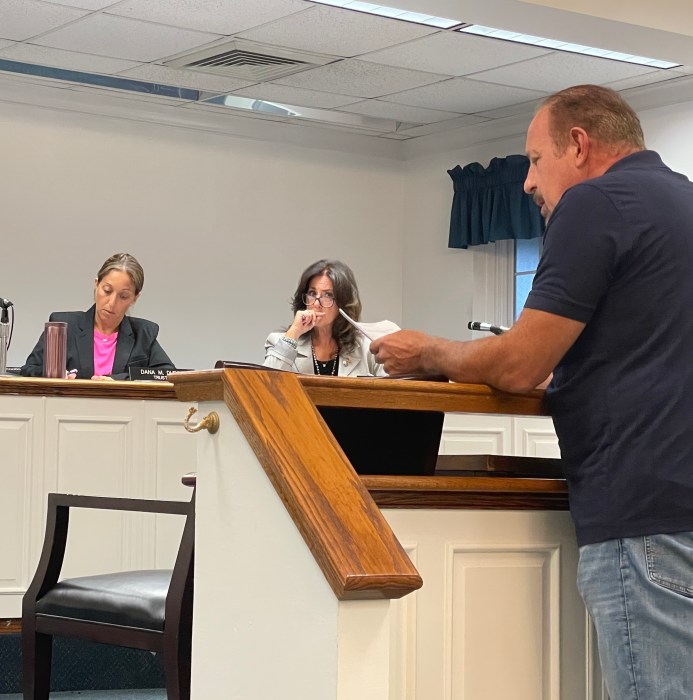Ways to cut an anticipated $937,515 revenue gap in next year’s school budget occupied the Oyster Bay-East Norwich Board of Education at their recent meeting.
Phyllis Harrington, superintendent of schools for the Oyster Bay-East Norwich Central School District, outlined cutbacks in elementary school class size, reducing one fulltime position in the English as a Second Language (ESL) support program to a part-time positions, and reduction in athletic programs and some elementary co-curricular activities at the board’s March 12 meeting at the Oyster Bay High School Library.
The meeting is the latest in a series of meetings to set the budget for the 2013-14 school year in time for voter approval on May 21 (See Oyster Bay Enterprise Pilot March 1.
At earlier meetings, school district officials explained the estimated spending plan of $53,967,475 necessary to maintain existing school programs — a $2,440,071 increase, 4.74 percent over the current budget. School officials noted that they anticipated a 3.06 percent increase in revenue, accounting for the $937,515 revenue gap.
In other business, the board voted to ask for voter approval for extending the district’s capital projects fund and to seek voter approval for as much as $1,720,000 in capital projects for the 2013-14 school year. Both ballot measures were discussed at the board’s previous meeting.
After outlining the cutbacks necessary, Harington announced that “we can meet the gap without cutting anything at the high school” other than limited cuts in the athletic programs. Some of the audience members broke out in applause in response.
Harrington detailed the specific reductions in class size at James H. Vernon Middle School, which would involve reducing the number of sections in grades four and six. Despite the reductions, she noted, class sizes at the two schools will continue to conform to the class size policy guidelines set by the board in the past.
In addition, Harrington detailed reductions recommended by the athletic department, including cutting two assistant junior varsity lacrosse coaches, two middle school lacrosse coaches, and one middle school football coach.
Furthermore, the athletic department recommended cutting the number of “yellow coats.” “Yellow coats” are staff members who wear yellow coats while monitoring the crowds and provide assistance at home games and meets. Yellow coats would be eliminated for middle school field hockey, track, and volleyball, and reduced for junior varsity boys and girls basketball and varsity football.
Other cost-saving measures include cutting the number of middle school athletic contests by 15, junior varsity by 19, and varsity by 42 to save on transportation and officiating. Varsity wrestling, track, cross-country, and golf teams would also attend fewer invitationals.
“Is it really necessary to have the yellow coats?” Dr. Michael Castellano, a board member, asked.
“They are there as a back-up” in case problems arise, Harrington explained. They are mostly teachers who know the students and are able to deal with potential difficulties.
Jim Mattel, school board vice president, wondered if the Town of Oyster Bay Public Safety personnel, whose cars are commonly seen round town, might be called in to assist at sporting events and save on yellow coats.
“I never explored that,” Harrington said. “It’s certainly worth looking into.”
Jim Robinson, a school board member, remarked, “You have a responsibility for the decorum of the crowd,” but added that there haven’t been problems.
Castellano suggested that if crowd control is a problem, perhaps there shouldn’t be spectators at events.
Harrington also explained that at Vernon, they would cut back on co-curricular activities other than student council, Leaders’ Club, and intramural sports. In response to a question, from board member Maryann Santos, Harrington replied that such activities as the chess club and the art club would be cut.
There are other anticipated expenses relating to taxes and other issues, Harrington explained. By taking a “calculated risk” and not including them in the budget — because of indications that the district will ultimately not have to pay for them — the district would save $220,000.
At the next meeting, March 19, Harrington noted, the board will consider the issue of revenue. She also explained that there is still hope that some state aid will be restored.
In other action, the board approved the hiring of a new science and technology learning supervisor, Janna Ostroff, for kindergarten through high school. “We are quite happy,” Harrington said, “to add her to our already amazing team.”
































